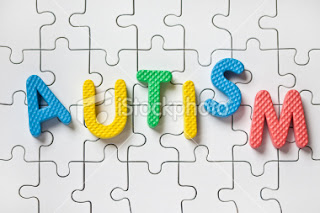Areas of difficulty
Autism is a form of developmental disability in which the most obvious characteristics are:
- lack of a normal emotional relationship with others
- impairment of communication
- reduced ability to learn, particularly through observation and by imitation
- the presence of repetitive behaviour patterns (e.g. rocking, hand flapping)
- obsessive rituals, and the desire to preserve ‘sameness’ in surroundings and routines
- lack of imaginative and creative play.
curriculum. As many as three-quarters of children with autistic disorders have IQ scores well below 70, and ongoing special education is required to address their learning needs. In Australasia, the United States of America and Britain, only about 12 per cent of children with autism receive their education in ordinary schools. However, most of the higher-functioning students, including those with Asperger Syndrome, do attend mainstream schools. Individuals with Asperger Syndrome have some of the behavioural and social difficulties associated with other degrees of autism, but they tend to have intelligence and language skills in the average or even above average range.
Teaching and management approaches for autism
Many different approaches have been used to reduce the negative behaviour often associated with autism, including drug treatment, diet control, therapy, behaviour modification and self-management training. Of these approaches, behaviour modification has produced the best results. Behaviour modification involves the setting of clear objectives for teaching compliant behaviour and eliminating inappropriate behaviour through direct teaching and positive reinforcement.
Many other approaches have been tried, including sensory-integration training, music therapy, play therapy, facilitated communication, speech and language training, and social skills coaching. A recent technique that
appears helpful in developing autistic children’s awareness of ‘normal’ codes of behaviour is the use of ‘social stories’. Social stories are simple narratives, personalised to suit the child’s own needs and behaviour, to which the child can relate. The theme and context of the story help the autistic child interpret and respond more appropriately to typical social situations; for example, sharing a toy, taking turns or standing in line.
There is general agreement that the focus of any support program should attempt to:
- stimulate intellectual development
- encourage language and communication
- promote social development.
- Be consistent in your management of the child (firmness plus affection).
- Gain the child’s attention, and speak clearly and simply to aid comprehension.
- Build up the child’s attention span.
- Challenge the child just enough to encourage progress towards new goals.
- Extend what you are teaching into different situations (for example, at home, out shopping, travelling on the bus).
- As far as possible, ignore attention-seeking behaviour and reward appropriate and compliant behaviour.
- For autistic children who lack speech, the use of visual cues (hand signing, pointing, picture cards, symbols) is usually necessary in most teaching situations.
that occur during the child’s daily life. Evidence has proved that the most effective teaching programs are highly structured and delivered with intensity.
New information, skills or behaviour need to be taught in small steps, using consistent and direct methods. All teachers, parents and other caregivers must know the objectives of the teaching and management program, and must work together to ensure consistency. It is essential that parents are trained in any special teaching or management techniques that are needed because the child spends more time at home than at school. Sewell10 writes, ‘Remember – everything you teach children with autism to do for themselves will be one more skill they will not have to depend on someone else to do for them the rest of their lives.’
Read More : Autism Student Teaching Approach
